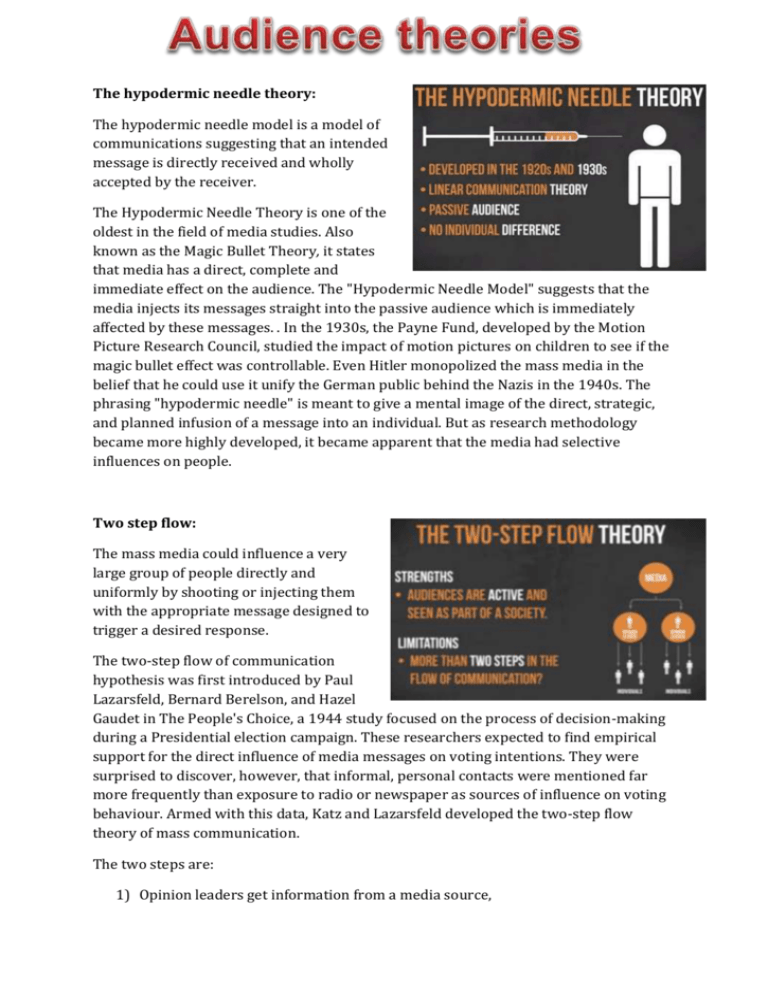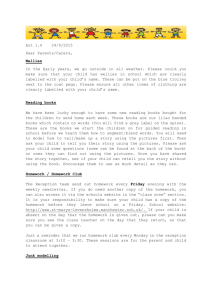Audicen theory hand out
advertisement

The hypodermic needle theory: The hypodermic needle model is a model of communications suggesting that an intended message is directly received and wholly accepted by the receiver. The Hypodermic Needle Theory is one of the oldest in the field of media studies. Also known as the Magic Bullet Theory, it states that media has a direct, complete and immediate effect on the audience. The "Hypodermic Needle Model" suggests that the media injects its messages straight into the passive audience which is immediately affected by these messages. . In the 1930s, the Payne Fund, developed by the Motion Picture Research Council, studied the impact of motion pictures on children to see if the magic bullet effect was controllable. Even Hitler monopolized the mass media in the belief that he could use it unify the German public behind the Nazis in the 1940s. The phrasing "hypodermic needle" is meant to give a mental image of the direct, strategic, and planned infusion of a message into an individual. But as research methodology became more highly developed, it became apparent that the media had selective influences on people. Two step flow: The mass media could influence a very large group of people directly and uniformly by shooting or injecting them with the appropriate message designed to trigger a desired response. The two-step flow of communication hypothesis was first introduced by Paul Lazarsfeld, Bernard Berelson, and Hazel Gaudet in The People's Choice, a 1944 study focused on the process of decision-making during a Presidential election campaign. These researchers expected to find empirical support for the direct influence of media messages on voting intentions. They were surprised to discover, however, that informal, personal contacts were mentioned far more frequently than exposure to radio or newspaper as sources of influence on voting behaviour. Armed with this data, Katz and Lazarsfeld developed the two-step flow theory of mass communication. The two steps are: 1) Opinion leaders get information from a media source, 2) Opinion leaders then pass on the information, along with their interpretation to others. Uses and gratification: Uses and gratifications theory is an approach to understanding why and how people actively seek out specific media to satisfy specific needs. UGT is an audience-centered approach to understanding mass communication. Originated in the 1970s as a reaction to traditional mass communication research, emphasizing the sender and the message. Stressing the active audience and user instead. Psychological orientation taking needs motives and gratifications of media users as the main point of departure. Blumler and Katz’s uses and gratification theory suggests that media users play an active role in choosing and using the media. Users take an active part in the communication process and are goal oriented in their media use. The theorist say that a media user seeks out a media source that best fulfils the needs of the user. Uses and gratifications assume that the user has alternate choices to satisfy their need. Uses and gratification theory can be seen in cases such as personal music selection. We select music not only to fit a particular mood but also in attempts to show empowerment or other socially conscience motives. There are many different types of music and we choose from them to fulfil a particular need. Reception theory: Reception theory is a version of reader response literary theory that emphasizes each particular reader's reception or interpretation in making meaning from a literary text. Reception theory is generally referred to as audience reception in the analysis of communications models. It originated in the late 1960’s by a man called Hans – Robert Jauss, the theory was the most influential theory in 1970’s and 1980’s Stuart Hall stressed the role of social positioning in the interpretation of mass media texts by different social groups. In a model by Frank Parkin, Hall suggests 3 hypothetical interpretive codes or positions for the reader of the text You will learn about negotiated reception, the understanding of environment and context as components of reception and using reception models such as celebrity. A quick overview: A branch of modern literary studies concerned with the ways in which literary works are received by readers. The term has sometimes been used to refer to reader‐response criticism in general, but it is associated more particularly with the ‘reception‐aesthetics’ (German, Rezeptionsästhetik) outlined in 1970 by the German literary historian Hans Robert Jauss. Drawing on philosophical hermeneutics, Jauss argued that literary works are received against an existing horizon of expectations consisting of readers' current knowledge and presuppositions about literature, and that the meanings of works change as such horizons shift. Unlike most varieties of reader‐ response theory, then, reception theory is interested more in historical changes affecting the reading public than in the solitary reader. The Bobo doll experiment: The Bobo doll experiment was the collective name of experiments conducted by Albert Bandura in 1961 and 1963 when he studied children's behaviour after watching an adult model act aggressively towards a Bobo doll. There are different variations of the experiment. The bobo doll experiment influences the age rating on films, this is to ensure that children aren’t watching an 18, as they copy what happens around them, so for example if a child went and watched The Kingsman, they would go around pretending they are Egsy and being a Spy, because that is what kids do. Passive and active audiences: The view (particularly associated with mass-media usage) that the audiences are not merely passive receptacles for imposed meanings (see hypodermic model) but rather individual audience members who are actively (albeit often unconsciously) involved— both cognitively and emotionally—in making sense of texts. An active audience is one that actively engages with the text. They do not simply accept every media message. They question what they see and develop their own interpretation of a media product based on their life experiences, education, family and cultural influences. ‘Bottom up’ theories generally assume an active audience. Theories such as “Uses & Gratification” and “Postmodernist theory” assume that audiences are active. A passive audience does not actively engage with a media text. A passive audience is one that does not question the message that the media is sending and simply accepts the message in the way the media outlet intended. ‘Top down’ theories of media influence tend to assume that audiences are passive. Theories such as “Bullet/Hypodermic” and “Agenda Setting Function” assume audiences are passive. Dyer – Fandom and Utopianism: While some have suggested that fandom is a pointless pursuit of escapism, Richard Dyer suggests otherwise. Fandom is not merely a celebration of fascistic utopia, but rather an active pursuit of utopianism. Fans are creative. They form social communities; they share ideas and common values and produce political statements. For example, Star trek signposts a utopian future where racism is a distant and forgotten prejudice. Fans responded to the show with a version of slash fiction in which homophobia was also a lost discrimination. This was a clear and creative initiative which used alternative representations to point to a new future. Dyer’s Utopian theory is linked with the Uses and Gratifications theory: - audiences consume media products with a clear set of pleasures to draw from that experience - Utopian theory - gratification that allows people to escape from their real lives - Reality - full of negatives and unfullfilment Gramsci – Power and hegemony: As a Marxist, he believed that society was structured unfairly. The rich upper classes were an elite in society who owned the means of production. This power gave them a control over the masses that work but do not receive their fair share of wealth. Indeed, 80% of the world’s resources are controlled by only 5% of the world’s population. Gramsci was interested in how this unfair status quo is maintained and reproduced. The idea of a ‘third face of power’, or ‘invisible power’ has its roots partly, in Marxist thinking about the pervasive power of ideology, values and beliefs in reproducing class relations and concealing contradictions (Heywood, 1994: 100). Marx recognised that economic exploitation was not the only driver behind capitalism, and that the system was reinforced by a dominance of ruling class ideas and values – leading to Engels’s famous concern that ‘false consciousness would keep the working class from recognising and rejecting their oppression (Heywood, 1994: 85). Hegemony is the theory that a wealthy, powerful elite maintain control over the lower social classes and project their own ideologies until the lower classes come to accept them as normal, and even desirable. This can be seen today as we are taught to want things like electronics or a car, modern hegemonic theory sates that as wealthy elite control our media, the media is used to control us and maintain status quo. Jenkins – Participatory cultures: In the last ten years, there has been an unprecedented amount of technological development, particularly in new media technologies and the Internet. Jenkins has written extensively about ‘convergence culture’; due to multimedia technology, different media forms and technologies have converged. Audience have become sophisticated ‘users’ of many different platforms of media which cross over. ‘Bert is Evil’ is an example – a photo-shopped image of Bert from Sesame St posing with Osama Bin Laden was published on line, found by accident by a print house in Pakistan, who had no idea who Bert was, and then printed on AntiAmerican posters, which were then filmed by CNN News and broadcast on American TV. Jenkins uses this example to shows how audiences are no longer just consumers, they are also producers and users. They create and consume, participate and publish, download and upload, receive and share. Blogs, network sites, web 2.0 and wikis are just some examples of audiences as powerful creatives within the world of Media production and reception. In 2006, Jenkins and co-authors Ravi Purushotma, Katie Clinton, Margaret Weigel and Alice Robison authored a white paper entitled confronting the Challenges of Participatory Culture: Media Education for the 21st Century. This paper describes a participatory culture as one: 1. With relatively low barriers to artistic expression and civic engagement 2. With strong support for creating and sharing one’s creations with others 3. With some type of informal mentorship whereby what is known by the most experienced is passed along to novices 4. Where members believe that their contributions matter 5. Where members feel some degree of social connection with one another (at the least they care what other people think about what they have created). Hebdige – Subculture and creating meaning: Subculture: The Meaning of Style is a 1979 book by Dick Hebdige, focusing on Britain's postwar youth subculture styles as symbolic forms of resistance. Drawing from Marxist theorists, literary critics, French structuralists, and American sociologists, Hebdige presents a model for analysing youth subcultures. Members of the working-class encounter daily hardships and alienation from the ruling hegemony (with Althusser's interpolation and Marx's class consciousness as the theoretical framework here). Younger generations are reluctant to suffer what their parents go through without protest. These youngsters develop distinct styles and practices with manifest their separate identity, condition and subversion. They encounter young black of Caribbean origin which have a much more historically grounded and formed reason for protest and adopt some of their feature in order to form "white ethnicity'. The media discovers the subculture (and thus essentially baptizing it) with a reaction that is typically moral panic. The subculture expands while in the process losing its rebellious edge either by turning into another commercial consumer product or by the media humanistically exotisizing its members, rendering them as harmless "clowns", and now the mainstream hegemony can again return to its peaceful unthreatened state.







